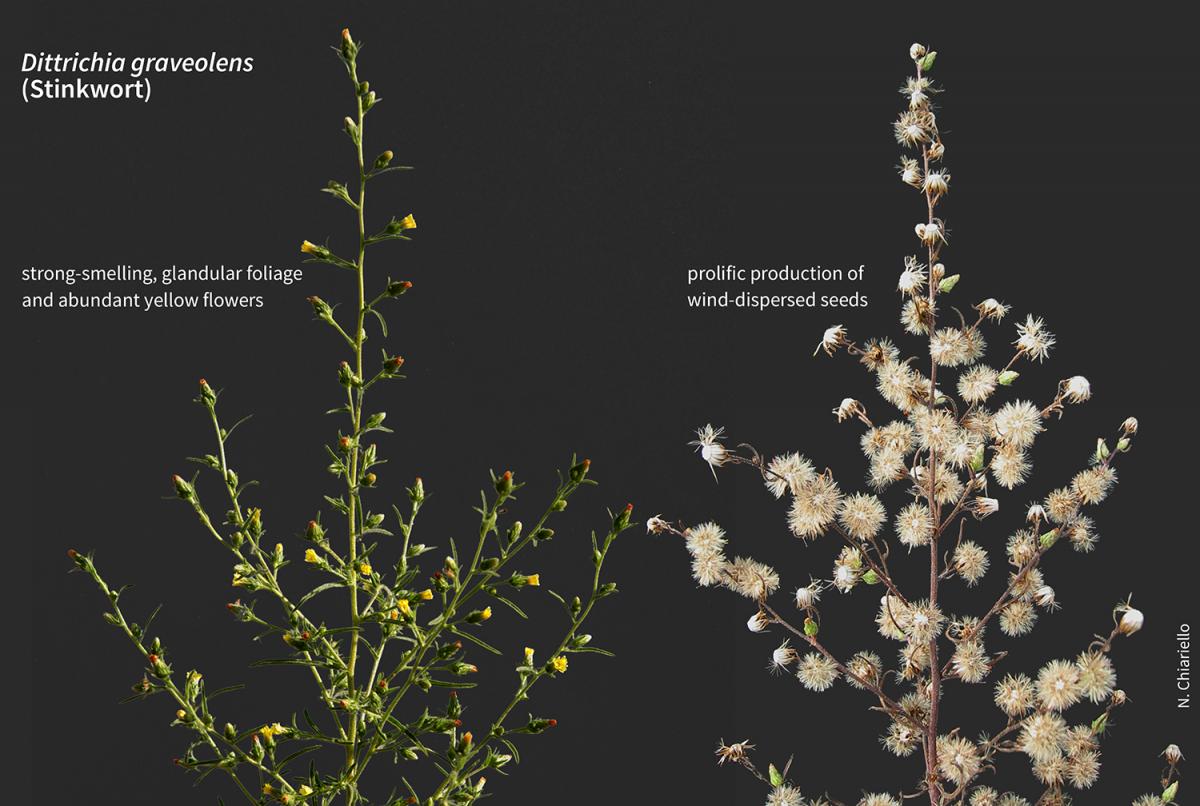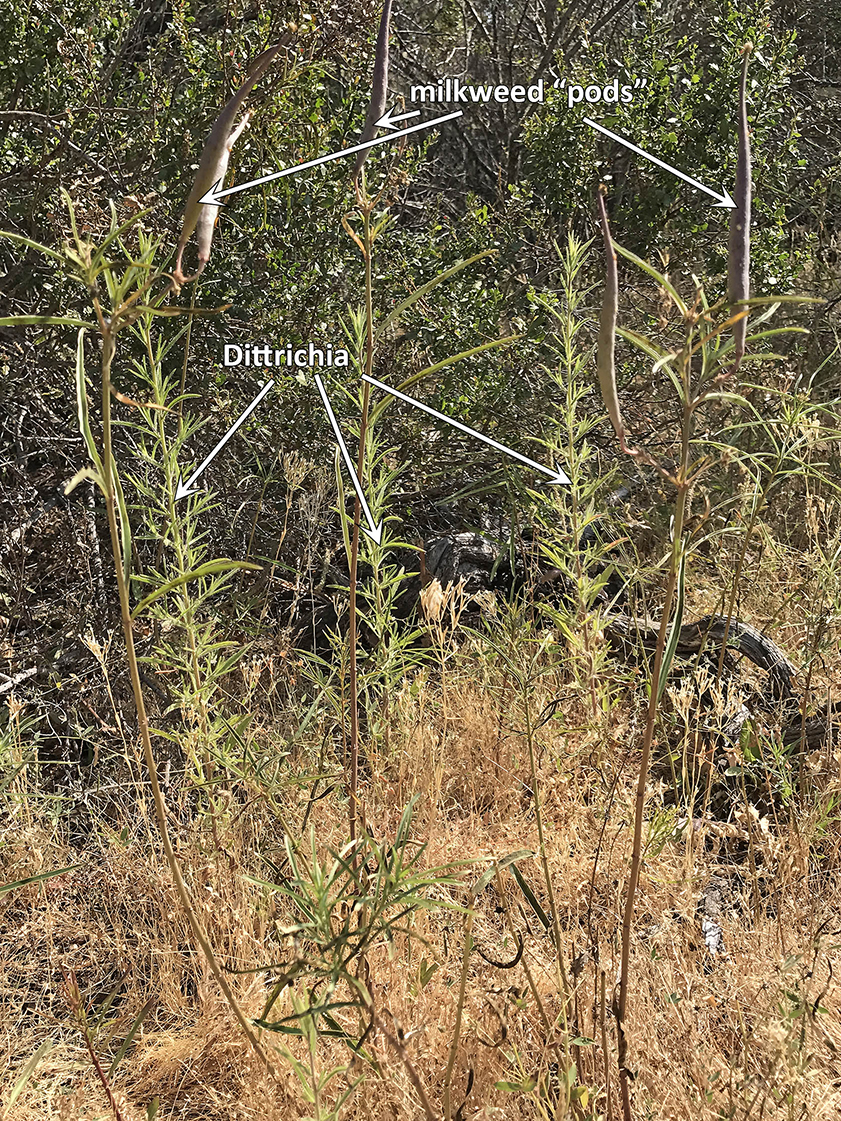Dittrichia graveolens (stinkwort) management
Dittrichia graveolens (stinkwort) is an annual plant native to the Mediterranean region of Europe that has rampantly spread outside its native range. It is considered a high risk species in terms of invasion potential and impact for the United States. The resinous foliage is unpalatable to animals, so there are few natural checks on its growth. A single stinkwort plant can produce tens of thousands of seeds that can be dispersed long distances by wind or by clinging to animals or equipment. The rate of spread in California has been dramatic. Its seeds are highly viable, achieving germination rates up to 90% in less than 17 days. Stinkwort was first recorded in California in 1984 near Milpitas (Santa Clara County). By 2012, it was present in 36 of California’s 58 counties. It has also invaded other states in the U.S., and other regions of the world.

Stinkwort first appeared in JRBP in 2005 in an area that had been mowed to provide a fire break and a fire response staging area near the boundary with the Westridge neighborhood. The plants were recognized by Jasper Ridge docents and researchers thanks to their awareness of new invasive species. All of the stinkwort plants that could be found within JRBP were removed by hand-pulling.
Annually since 2005, Jasper Ridge staff and volunteers have repeated the process of surveying for stinkwort and removing it by hand or with weed wrenches. Re-invasions have occurred every year, making it clear that a few years of house-cleaning were not the answer. In 2007, we learned that a property near JRBP had an extensive stand of stinkwort. Its location suggested it would be a source of invasion into Jasper Ridge, and may have been the source of the invasion in 2005. In order to protect Jasper Ridge, we made a first-ever effort to help manage stinkwort on a neighboring property (2006-07 annual report, pg. 5). Since then, the number of source populations has expanded greatly, and stinkwort’s invasion into JRBP appears to be coming from all directions.
By surveying for stinkwort within JRBP multiple times per year, by asking docents to be on the lookout, and by hand-pulling or cutting every plant we find, we have succeeded in maintaining a near-zero status for stinkwort throughout 99 percent of Jasper Ridge. Our goal is to protect JRBP’s native plant diversity and ecosystems. We have found stinkwort invading many habitats, including a moist valley where a native species of milkweed has been observed for decades. Stinkwort also does very well in areas where the ground is bare or nearly bare, such as fire breaks and the edges of roads and trails. Seedlings typically emerge from fall through spring following precipitation events, but seedlings may also arise in the summer. Our protocol is to remove plants as thoroughly as possible before flowers form, limiting the next year’s stinkwort population to the number of seeds that disperse into JRBP. In some years, we have had to remove many thousands of plants, and in other years, the job has been much smaller.

In one area of JRBP, equal to about one percent of the preserve’s total acreage, we have followed a different management policy. In this area, historical impacts have resulted in weed-dominated vegetation, and current land-use goals involve multiple management considerations in addition to native plant protection. We have worked with other another division at Stanford—Lands, Buildings, and Real Estate (LBRE)—on a containment strategy that emphasizes mowing. Over time, the stinkwort infestation has diminished in this area, and now is concentrated on the edges of old roads.
Whether to develop a much more intensive stinkwort removal effort for the area now treated primarily with mowing will be addressed by a new JRBP strategic plan. The plan will need to consider many factors: What kinds of plants will take the place of stinkwort in such a weed-dominated habitat? How will sensitive amphibians and other wildlife respond to the disturbance associated with removal of stinkwort? Are there especially strong vectors that will continue to re-introduce stinkwort in vast numbers? Will the maintenance of fire breaks and other fire-reduction measures counteract our efforts to eliminate stinkwort? These issues illustrate the enormous challenge of controlling an extremely invasive species that is highly adapted to our environment, especially in the context of a fragmented landscape with multiple land management goals.
JRBP’s policies of “pull-every-plant” and “mow-where-you-can” are not feasible across the entire expanse of Stanford University lands, which span seven times the area of JRBP and have a much greater diversity of land management goals. In addition to outdoor education and research, Stanford lands support public recreation, farming, and cattle grazing, all balanced against the needs of fire prevention, habitat conservation, and restoration, including protection of sensitive species such as California tiger salamanders. Despite these multiple-use considerations, stinkwort has declined substantially on some Stanford lands through targeted efforts, notably on Dish Hill, which has benefited from constructing paved trails and restricting off-trail access. LBRE continues to be a partner in protecting Jasper Ridge from stinkwort and other invasive species, as well as continuing to evaluate the feasibility of control measures across all Stanford lands.



